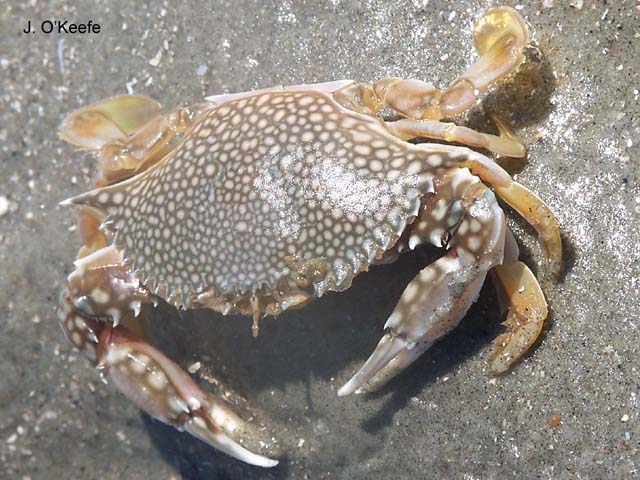| Portunidae (swimming crabs) |
| 14.1 cm CW (male/unsexed) |
|
benthopelagic; marine; dH range: 27.5 - 35; depth range 0 - 68 m |
| Western Atlantic: USA to Argentina. |
|
Carapace more than twice as broad as long; 9 teeth on broadly arched anterolateral margin (outer orbital tooth and strong lateral spine included); front not so advanced as outer orbital teeth, bearing, between the inner orbital angles, one pair of bicuspid teeth (resulting from the coalition of 2 separate pairs). Convex dorsal surface finely granulate, fissures on orbital margin broadly open; lower surface of carapace hairy; pincers moderate-sized; legs rather short and broad, densely fringed with hairs; fifth legs flattened in form of paddles. Basal segment of abdomen produced on each side into a strong, sharp, slightly upcurved spine. Color: dorsal surface, including pincers, light reddish brown to olive brown covered with many small, rounded white spots, tips of walking legs yellow; color pattern persisting in alcohol. |
| Minimum carapace width: 2.28 cm (Ref. 93549). Inhabits shallow water along ocean sand beaches and is well adapted to life in the waves and shifting sand; usually in bottom burrows at daytime and emerges at night, at temperatures of 27.5 to 28.6°C and salinities of 27.5 to 35 ppt. Presumably feeds on a variety of items including mollusks, other bottom invertebrates, and some fishes, carrion and detritus (Ref. 367). |
|
Not Evaluated (N.E.) Ref. 123251)
|
|
|
Source and more info: www.sealifebase.org. For personal, classroom, and other internal use only. Not for publication.

